Employee Generated Content: How Employees Become Top Brand Advocates
In the search for authentic brand advocacy, B2B marketers have long turned to satisfied customers and industry influencers. But what if your most powerful brand ambassadors were already on your payroll, waiting to be activated?
Enter employee-generated content (EGC), a strategy that turns your team into brand ambassadors sharing their genuine experiences and expertise. Unlike traditional employee advocacy, where employees simply share pre-approved company messages, EGC encourages staff to create content in their own voice.
Think about it. Who knows your company better than the people who work there every day? And their voices carry weight. In a recent Sprout Social survey, 87% of respondents reported feeling more connected to brands whose employees share information about the company.
By finding and elevating your organisation’s natural brand ambassadors, you can turn them into powerful advocates who can showcase your company’s culture, values, and expertise in their own voice.
Sign up for our newsletter
Get the latest news and ideas from 1827 Marketing sent directly to your in-box.
You will receive an email from us every couple of months, and you can opt out at any time.
What is Employee Generated Content?
Employee-generated content (EGC) is digital content – blog posts, social media updates, videos, podcasts, and more – created and shared by employees. EGC focuses on some aspect of their employment, such as the company’s products, services, industry, or even recent certifications the employee has obtained.
True EGC is created voluntarily by employees, often outside their primary job responsibilities, and can provide insider perspectives on a company’s culture, values, and expertise.
Younger employees in particular are often eager to engage. In fact, Sprout Social found that 81% of Millennials thought it was important for employees to participate in employee advocacy.
Employees can be motivated to create EGC by any number of factors, including:
Personal Brand Building: Employees may see EGC as an opportunity to establish themselves as thought leaders in their field, enhancing their professional reputation and career prospects.
Recognition and Visibility: EGC can provide a platform for employees to showcase their skills and knowledge, potentially leading to recognition from colleagues, management, and even industry peers.
Professional Development: Creating content can help employees deepen their understanding of their work and industry, contributing to their professional growth.
Desire to Share Knowledge: Many employees are passionate about their work and genuinely want to share their insights and experiences with others.
Networking Opportunities: Creating and sharing content can help employees connect with colleagues, industry professionals, and potential clients or partners.
Job Satisfaction: Contributing to the company’s success through content creation can increase an employee’s sense of purpose and job satisfaction.
When leveraged effectively, EGC can enhance a company’s brand, improve employee engagement, and provide valuable insights to customers and potential hires.

Benefits of Employee-Generated Content
From organically expanding your brand’s reach and engagement to building trust and showcasing your company culture, EGC helps humanise your brand in ways traditional marketing can’t. It also plays a crucial role in attracting and retaining top talent, all while providing a cost-effective approach to creating content that resonates deeply with your audience.
Expands Reach and Engagement
Employee-generated content typically receives higher engagement rates on social media platforms than brand-created content. No surprise there, considering a recent LinkedIn study found that employees’ networks were ten times larger than companies’ follower bases.
Because of this, EGC offers a compelling opportunity for B2B marketers to connect organically with a broader audience, including decision-makers and influencers who might not follow official company channels. And employees’ audiences are listening: TINT’s 2024 State of Community Powered Marketing reported that EGC gets shared 24 times more than branded content.
Increases Trust
Because EGC comes from real people rather than corporate entities, audiences perceive it as more authentic and trustworthy. So trustworthy, in fact, that leads developed through employee advocacy are seven times more likely to convert .
B2B companies can foster stronger connections with their target audience and build credibility in their industry by leveraging internal subject matter expertise with employees positioned as the stars.
Humanises the Brand and Showcases Company Culture
EGC helps humanise the brand by putting faces and personalities to the company name. By sharing behind-the-scenes content, personal experiences, and day-to-day activities, employees can effectively showcase the company culture, making the brand more relatable and appealing to potential clients and partners.
Talent Attraction and Retention
By highlighting employee experiences through EGC, B2B companies can attract top talent in their industry. Prospective employees gain insights into the work environment and company values, which can be a powerful recruitment tool. Additionally, involving employees in content creation can improve job satisfaction and retention rates.
Improves Engagement
Implementing an EGC strategy can enhance internal communication and employee engagement. When employees are involved in creating content about their work and experiences, it fosters a sense of ownership and pride in the company, leading to a more connected and motivated workforce.
Cost-Effective Content Creation
Using a combination of professional content and employee contributions in social media can be a cost-effective way to diversify a B2B company’s content strategy .This approach allows for a steady stream of content without significantly increasing marketing budgets. The result is a richer, more diverse, and more engaging content ecosystem for your audience.
By leveraging these benefits of EGC, B2B marketers can create more authentic, engaging content that resonates with their audience while boosting employee morale and brand reputation. This strategy can improve marketing outcomes, strengthen brand positioning, and foster a more engaged workforce.
Types of Employee-Generated Content
By encouraging employees to create content across different formats and subject areas, companies can develop a rich, diverse content ecosystem that represents their brand, culture, and expertise. This approach allows for a comprehensive content strategy that appeals to different audience preferences and covers a wide range of relevant topics.
Content Formats
Short-Form Written Content: Social media posts, brief updates, and short articles shared on platforms like LinkedIn, Twitter, Facebook, and company intranets.
Long-Form Written Content: Blog articles, white papers, case studies, and in-depth thought leadership pieces published on company blogs or industry publications.
Video Content: Vlog-style content, educational tutorials, interview series, live streams, and short promotional videos .
Audio Content: Podcasts, audio versions of blog posts, and recorded interviews or discussions.
Visual Content: Infographics, photos, custom graphics, memes, and data visualisations.
Interactive Content: Quizzes, polls, surveys, and interactive presentations created by employees.
Subject Areas Your Employees Could Tackle
By tapping into your workforce’s diverse experiences and expertise, you can create authentic and engaging content that feels genuine and relatable, helping it resonate with internal and external audiences.
Below, we’ll explore key areas where employees can make a significant impact through EGC, including showcasing insights and opinions, sharing behind-the-scenes moments, and highlighting company values.
Expert Opinions
Employees can share their insights on industry matters, providing valuable perspectives to clients and peers. Employees could discuss relevant topics on webinars, livecasts or podcast episodes, or share their takeaways from industry conferences and events.
EGC also allows for the rapid response to emerging trends on social media and online groups, complementing more in-depth pieces that take longer to develop.
Behind-the-Scenes Content
Employees can showcase the company culture, appealing to potential hires and clients interested in company operations. They might share ‘day in the life’ style videos, content about professional development opportunities, or photos and videos about company events. These act as testimonials on what it is like to work at the company.
Product Experience Sharing
Employees can provide information about products and services, such as tutorials, demonstrations, and customer success stories. This can be particularly valuable in B2B contexts where trust and expertise are crucial factors in decision-making.
Internal Knowledge
Internal audiences can also benefit from EGC. Experienced employees sharing workflows, best practices, and training materials they’ve found useful can benefit newer hires. Public recognition of employee achievements, milestones, volunteering, and CSR initiatives can also boost morale and team cohesion.
Community Involvement and CSR
EGC can showcase a company’s commitment to CSR and community engagement. Employees can share experiences from volunteer events, sustainability initiatives, or charitable partnerships, demonstrating the company’s values in action. This can inspire others to participate and helps build a positive brand image that can attract socially conscious clients and potential employees.

Examples of Employee Generated Content in Action
Nothing drives home the ability of EGC to build trust and drive meaningful engagement in the B2B space like real-world examples. We’ve highlighted several standout instances where companies successfully leveraged employees’ voices to amplify brand reach, engage audiences, and showcase company culture. We’ve also added a few stellar B2C examples with crossover appeal.
Microsoft’s Engaging LinkedIn Content
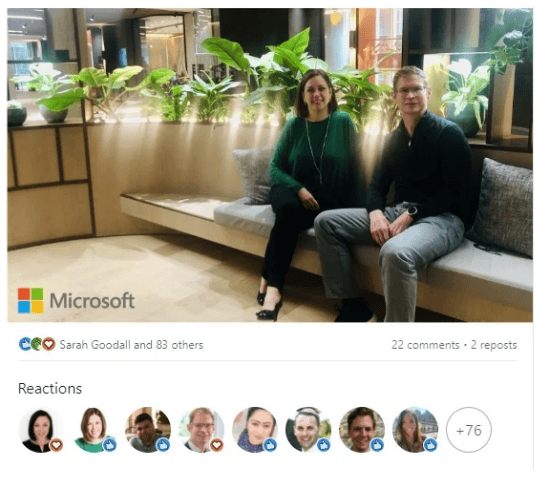
Perhaps it’s no surprise that Microsoft’s employees have a knack for engaging LinkedIn content. Among a talented group, Lee Welch stands out not only for his posts, but for regularly taking an opportunity to engage with his audience. Think about it: when you see that the original poster is actively engaging with readers, as Welch does, isn’t it all the more tempting to enter the conversation?
#AdobeLife
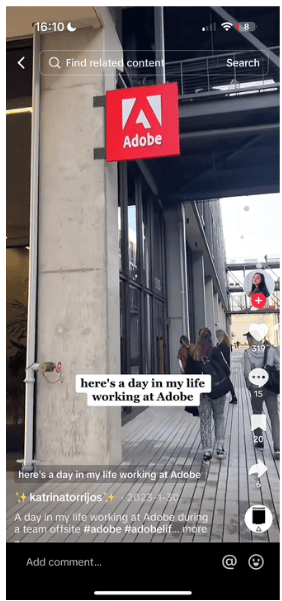
Adobe encourages its employees to share their unique perspectives, work experiences, and creative endeavours through social media platforms using the hashtag #AdobeLife. This initiative offers a double benefit: employees’ content is associated with the Adobe mega-brand, and Adobe gets oodles of free content that highlights their culture of inclusivity and recognition, driving sales and even helping attract new talent.
#WeAreCisco
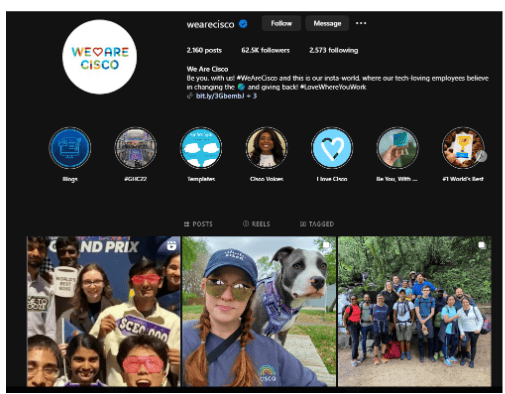
Much like Adobe, B2B megabrand Cisco leverages EGC to give customers (and potential employees) a glimpse of the company’s culture. Employees are encouraged to post from internal events and tell their unique stories – often to great effect. IBM also encourages employees to spotlight culture by posting about corporate events and team outings.
Duolingo
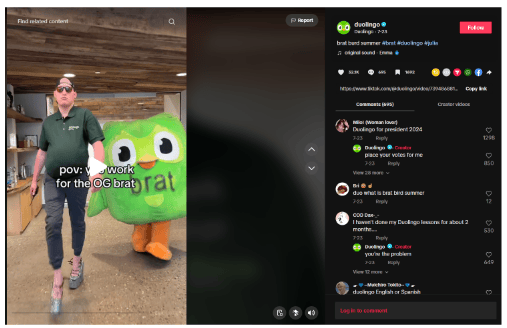
Duolingo has leaned into a bit of internet subculture that’s developed around its green owl mascot, Duo. Driven by the app’s frequent reminder notifications, he’s garnered a reputation as being a bit of a brat, to put it mildly. Duolingo employees routinely depict poor Duo sorting out existential crises while waiting for users to respond to his reminders about their streaks – and audiences eat it up.
While we’re not suggesting you take this B2C brand’s playful approach if your firm handles crisis management PR to help companies navigate the fallout from scandals, where appropriate some self-aware humour just might help you stand out in a crowded enterprise service space.
Marks and Spencer
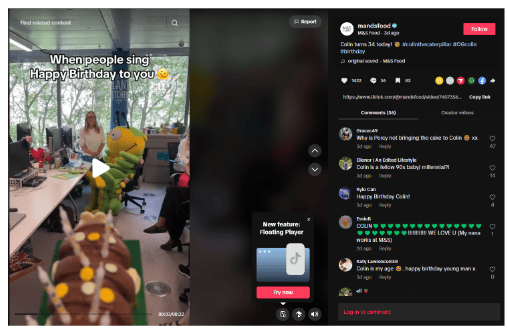
The M&S TikTok account is loaded with top food and clothing picks, cute skits featuring employees, and plenty of Colin and Percy cameos. M&S also leverages individual stores’ accounts to help customers get a sense of each store’s unique staff, vibe, and promotions – keeping them connected even when they’re not in the market for a doughball Christmas tree. Whilst M&S is also B2C-focused, it’s still a great example of leaning into what people love about your brand in EGC.
Implementing an EGC Strategy
Now that you’ve seen some of the best in action, it’s time to think about how you can effectively incorporate EGC into your B2B marketing strategy. While there’s certainly more than one right way to go about it, the reverse is also true, as charging in blindly opens your team up to miscues that can completely derail your efforts.
We suggest following the guidelines below for a thorough but manageable approach to EGC:
Start small: Launch your EGC initiative with a small group of highly engaged employees who are already natural brand advocates. Hint: they’re the ones already posting about work milestones and day-to-day office happenings or sharing posts from your company’s LinkedIn or Facebook accounts.
Keep participation voluntary: While you can encourage content creation by offering rewards or recognition for employees who create high-quality content, keeping participation optional is crucial for maintaining authenticity. Plus, team members who are uncomfortable creating content can still be meaningful contributors by interacting with each other’s content through comments, likes, and shares to amplify colleagues’ voices and your brand’s reach.
Provide resources and training: Boost your EGC team’s confidence and establish quality standards by equipping them with style and branding guides, content creation tools, and ongoing training around the latest techniques in content creation. Over time, as these initial contributors see success, more employees will likely join in, creating a snowball effect that amplifies your brand’s reach. Your training should also keep contributors abreast of trends and their meanings – just because all the kids are posting “Skibidi!” and getting gobs of engagement doesn’t mean it’s appropriate for your brand to follow suit (spoiler: it’s not).
Clarify Your Mission Statement and Brand Values: Give your employees the autonomy to create content on topics they’re passionate or knowledgeable about, but ensure they also have clear guidelines around what kind of content aligns with the company’s brand voice and objectives. Developing and communicating a clear mission statement and well-defined brand guidelines is essential to mitigate risks and ensure that all employee-generated content reflects your company’s values and mission.
Address concerns and offer feedback: Be open to addressing employees’ concerns about creating content, such as time constraints or privacy issues. Provide constructive feedback on employee content to help improve quality over time.
Measure and share results: Regularly track the performance of EGC initiatives using metrics such as engagement rates, reach, and lead generation. Sharing these results with employees provides transparency and motivates them to continue contributing by showing the tangible impact of their efforts.

Challenges and Solutions in Implementing Employee Generated Content (ECG)
Although employee-generated content offers immense potential for B2B marketing, implementing an EGC strategy requires effort and focus. From driving and sustaining organic employee participation to maintaining consistent quality and brand fidelity, the challenges are very real – but not insurmountable. In fact, with the right approach, it’s possible to turn these obstacles into opportunities. Below, we’ll explore some key EGC challenges B2B marketers may encounter and offer practical solutions to overcome them.
Lack of Employee Participation
Problem: Employees may be hesitant to create content due to time constraints, lack of confidence, or fear of criticism. How do you get the ball rolling?
Solutions:
Start with a small group of enthusiastic employees as early adopters.
Provide training and support materials, offer incentives, and showcase successful content to inspire others.
Make content creation as easy as possible by providing templates and tools.
Sustaining Long-term Engagement
Challenge: Once your EGC machine is running, you must maintain employee enthusiasm and participation over time. What can you do to keep people engaged and the content flowing?
Solutions:
Create a system for amplifying employee content through company channels, reinforcing the symbiotic relationship between personal and company brands.
Regularly refresh your EGC program with new challenges or themes.
Recognise and reward top contributors. Share success stories and the impact of employee content to keep motivation high.
Balancing Employee Authenticity and Brand Control
Challenge: Empowering employees to create content that feels genuine is important, but you need to ensure that they don’t inadvertently damage your brand. How can you maintain brand fidelity while encouraging authentic expression?
Solutions:
Consider a tiered approach where employees with more experience or seniority have more freedom in content creation.
Educate on how strong personal brands can enhance the company’s reputation and vice versa.
Provide examples of content that successfully balances authenticity and brand alignment.
Consistency in Messaging
Problem: It’s hard enough to keep content aligned with overall brand messaging and marketing objectives when it’s just the marketing department creating it. What happens when all of your employees are ‘helping’?
Solutions:
Create a content calendar and share key themes or topics with employees.
Regularly communicate company values, goals and priorities.
Use content management systems with built-in compliance features, such as keyword flagging or mandatory review workflows.
Maintaining Content Quality
Problem: Ensuring all employee-generated content meets brand standards and quality expectations is a worry for most marketing departments. How do you ensure that EGC doesn’t result in a massive drop in standards?
Solutions:
Provide examples of high-quality content.
Create guidelines that clearly outline what can and cannot be shared.
Implement a peer review and feedback system to help improve content quality over time.
Offer constructive feedback and ongoing training to help employees improve their content creation skills.
Legal and Compliance Risks
Challenge: By its very nature, EGC opens companies up to risks around confidentiality, intellectual property, and industry regulations. It’s enough to make any legal department break out in a collective cold sweat, especially in highly regulated industries like finance, healthcare, or legal services. How can you navigate these challenges?
Solutions:
Develop clear social media and content creation policies. Include details on legal and compliance issues.
Implement a review process for sensitive topics, industries, or any content that mentions clients, involving compliance officers or legal teams where necessary.
Ensure employees understand the need to obtain client approval through company channels for any content that references their work, even if not named directly.
Measuring ROI
Challenge: Tying EGC initiatives to revenue generation can be tricky. How do you quantify the benefits of EGC for shareholders to justify continued investment?
Solutions:
Set clear objectives and KPIs for your EGC program.
Use analytics tools like Google Analytics and Hootsuite to track engagement, reach, and conversion metrics.
Regularly report upwards on successes and learnings to build support.
EGC in a Crisis
Challenge: EGC can be a powerful tool or a risk multiplier during corporate crises. Handled well, EGC can demonstrate transparency, build trust, and showcase the company’s values in action. If not, it can exacerbate the crisis, spread misinformation, damage the company’s reputation, and undermine crisis management efforts. What steps can you take to be prepared if the worst happens?
Solutions:
Closely monitor employee content during crises and be prepared to act quickly if issues arise.
Develop crisis communication guidelines specifically for employee content creators.
Identify key employees who can act as authentic voices during a crisis. Train them on crisis communication principles and the company’s crisis management plan.
Creating pre-approved content templates for different crises can help ensure consistent messaging.
Designing Effective Employee Training Programs for EGC
Proper training programs can address many challenges you will likely encounter when implementing an EGC strategy. To empower employees to create high-quality, relevant content, consider the following when designing training programs:
Start with the basics: writing for different platforms, understanding audience needs, and using data effectively.
Provide training on your company’s brand voice, key messages, and content guidelines.
Show employees how to discuss their work in general terms without revealing specific client details.
Offer workshops on specific content types (e.g., blog writing, video creation, podcast production).
Provide hands-on practice sessions where employees can create and receive feedback on content.
Consider creating a mentorship program where experienced content creators can guide newcomers.
Regularly update training materials to reflect new platforms, tools, or best practices.
Remember, the goal is not just to teach skills but to inspire confidence and creativity in your employees.

Company Leaders’ Role in Employee Generated Content (EGC)
Leadership plays a central role in promoting and facilitating EGC production within a company.
Here are some key ways leaders can encourage and support EGC:
Lead by example: Leaders should actively create and share their own content, demonstrating the value and importance of EGC.
Create a supportive environment: Foster a culture where employees feel comfortable sharing their ideas and experiences without fear of criticism.
Showcase employee content: Get senior leaders to share and promote employee-generated content across company channels to demonstrate its value.
Integrate EGC into strategy: Make EGC a core part of the company’s marketing and communication strategy, not just an afterthought.
By taking these actions, leaders can create an environment that encourages and values employee-generated content, leading to more engaging internal and external communication.
Taking EGC Further
While EGC will always be an essential part of your mix for driving leads and sales, it’s important to consider other ways you can leverage the power of authentic employee content as your initiative matures. Below, we’ll cover how to use EGC to establish your brand as a thought leader within your industry and enhance your account-based marketing (ABM) initiatives.
Using EGC to Develop Thought Leadership
EGC can be a powerful tool for identifying and cultivating thought leaders within your organisation.
Once you’ve identified employees with potential for thought leadership in specific practice areas or industries, offer them opportunities to create in-depth content on their areas of expertise, then support them with editorial assistance, data analysis, and design resources to enhance their content.
You should also amplify their content through company channels and industry publications. To take it one step further, provide opportunities to participate in industry events, webinars, or podcasts to further establish their expertise.
Track the impact of their content on lead generation, client engagement, and industry recognition. By closely monitoring these metrics, you can demonstrate the tangible benefits of EGC initiatives to internal stakeholders. This helps justify the ongoing time investment and provides a roadmap for scaling efforts across other departments and practice areas.
Encourage a feedback loop where thought leaders can refine their content based on what resonates most with your audience, further aligning their expertise with market needs and enhancing the overall impact of your EGC strategy.
Remember, developing thought leaders takes time and consistent effort, but the payoff in terms of brand reputation and client trust can be significant.
Integrating EGC with Account-Based Marketing (ABM)
EGC can also be a valuable component of an account-based marketing strategy in professional services. By aligning EGC with ABM, you can leverage employee relationships and networks to share relevant content directly with key decision-makers at target accounts.
Encourage employees who have these relationships to work with the marketing team to create content targeted to the decision-makers in their networks. Align topics with the interests and challenges of your target accounts and use EGC to build the case for your firm’s expertise in the industries or problem areas relevant to them.

Don’t Overlook the Power of Your Internal Brand Advocates
As B2B marketers, we often look outward for brand advocacy. But your most powerful voices may already be within your organisation. Employee-generated content (EGC) transforms your workforce into authentic brand ambassadors, enhancing your reach and credibility while boosting employee engagement.
Implementing EGC isn’t without challenges. It requires clear guidelines, ongoing support, and a culture that values employee voices. But when done right, the rewards are substantial. Your team’s insights and experiences can resonate with audiences in ways that polished corporate messaging simply can’t match.
Ready to turn your employees into your brand’s most powerful asset? Whether you’re just starting out or looking to refine your existing strategy, the 1827 Marketing team is here to help. We’ll work with you to identify your natural brand advocates, develop a tailored EGC strategy, and integrate employee voices seamlessly into your marketing efforts.
Have a B2B marketing project in mind?
We might be just what you’re looking for






